Abstract
The relevance of this study is due to the importance of studying personal factors that determine the patterns of individual self-realization. One of these factors is self-control that in our opinion largely defines the self-realization of an individual. The purpose of the study was to identify the specific features of self-realization in students with different levels of self-control. To achieve this goal, an empirical study was conducted with the participation of 140 students aged 17–25. As diagnostic tools, the following methods were selected: the test “Self-control abilities” by N. M. Peysakhov; “Questionnaire of self-realization” by S. I. Kudinova. In the process of analyzing empirical data, the subjects were divided into five groups (according to the level of development of self-control abilities), where specific differences in the parameters of their self-realization were studied. The analysis revealed that the most favorable self-control level in terms of self-realization is above average. Students with this level of self-control are active and optimistic; in the process of self-realization, they have equally high social-corporate and subjective-personal goals of self-realization; egocentric and sociocentric motives are equally present. The most unfavorable for self-realization were low and high levels of self-control, as these groups of subjects revealed the predominance of passivity over activity, of egocentric self-realization motivations over sociocentric ones, low level of constructive self-realization along with social and personal barriers.
Keywords: Self-control, self-realization, self-realization attitudes, self-realization barriers
Introduction
Self-control is an important regulating mechanism in human life; it determines the success of any activity, from the planning process to the evaluation of results. According to Burdenyuk (1992), self-control is implemented and ensured through self-organization and self-regulation of a person. The question of the manifestation of self-control in the self-realization of an individual and the specific features of people with different levels of self-control remains open and not fully studied. The research on this issue will allow us to focus on self-control as a significant factor determining the success of self-realization of an individual.
Problem Statement
The problem of self-realization is central to human life and development. In the modern domestic systematic approach to self-realization, this phenomenon is understood as a set of instrumental-stylistic and motivational-semantic characteristics that ensure the constancy of aspirations and readiness for self-expression of the individual in various spheres of life (Kudinov et al., 2017).
The variability of self-realization areas requires a sufficiently developed self-control in order to choose a specific sphere of self-realization and adjust it in case of a disappointment. Self-control implies the ability of a person to set long-term goals, predict future results, plan and evaluate their results in the process of implementing their ideas (Peysakhov, 1991).
The extent to which a person has developed self-control depends on his or her ability to choose, follow his or her own path of development and respond to external factors in a flexible way.
Research Questions
The concept of self-realization is widely considered in the works of A. Maslow and K. Rogers. Self-realization acts as a process of self-realization, namely the realization of an individual’s potential in life, the search and affirmation of one’s path in this world, one’s values and the meaning of one’s existence.
Self-realization research focuses on the study of conditions, factors and determinants of successful self-realization (Egorova et al., 2020). In modern Russian psychology, Kudinov et al. (2017) developed a polysystem model of self-realization, which for the first time discusses in detail the characteristics, types and conditions of self-realization.
Peysakhov (1991) made a significant contribution to the study of self-control in the Russian psychological science. He understands self-control as an ability of an individual to set long-term goals, predict future results, put forward quality assessment criteria, independently plan their actions, as well as extract the necessary information about the course of the control process and adjust it. Also, Peysakhov (1991) notes that self-control is a creative process, as it is associated with the creation of the new, being faced with an unusual situation or contradiction, with the need to set new goals, search for new solutions and means to achieve these goals. At the same time, under the developed method “The ability of self-control” Peysakhov (1991) highlights an important fact about this quality—strong self-control poses the danger that a person may be too calculating and rational, while poor self-control can be dangerous because of the lack of an integral system of self-government and the predominance of emotional assessment over rational analysis (Bowlby, 2014; Shevtsov, 2008).
Modern foreign psychology considers the capacity for self-control as part of self-identity, without which it is not possible to achieve the full realization of your potential (Rusu, 2019); the basis for the self-realization choice is the ability to control your attention (Goukens et al., 2009). The theory of self-determination (Weinstein et al., 2011) also describes how managed self-control positively affects a person by making him or her more energetic when it comes to developing their capabilities. Also, self-control is considered as a psychological resource for the success of university education (Borzova & Mosunova, 2020; Sava et al., 2020) and further professional activity (Fomina et al., 2020; Halama, 2017; Pilotti et al., 2019).
This statement is also confirmed by representatives of the systematic approach to self-realization, Kudinov and his colleagues (2017). They experimentally found that students with low persistence and external control locus are not successful in self-realization, while students with high persistence and internal locus of control successfully realize themselves in various areas.
Purpose of the Study
The purpose of this work is to study the specifics of self-realization in students with different levels of self-control.
Research Methods
The empirical study uses the following methods as diagnostic tools: the test “Self-control” by N. M. Peysakhov; “Questionnaire of self-realization” by S. I. Kudinova.
The analysis of empirical data was carried out using statistical analysis of mean values, correlation analysis, the values of the Kolmogorov-Smirnov test for unrelated samples, and the Student's-test (for independent samples) were calculated.
140 students aged 17–25 from Sholom Aleichem Priamursky State University took part in the study.
Findings
According to the results of the diagnosis, five samples of subjects were formed:
- sample 1 (S1) - respondents with poor self-control (24 respondents);
- sample 2 (S2) - respondents with a lower than average level of self-control (30 respondents);
- sample 3 (S3) - respondents with an average level of self-control (33 respondents);
- sample 4 (S4) - respondents with a higher than average level of self-control (28 respondents);
- sample 5 (S5) - respondents with a high level of self-control (25 respondents).
The average values for the components of self-realization in the studied samples, obtained using the Self-realization Questionnaire of S. I. Kudinova, are shown in Figures 1–7 (Figure 1–7.).
The scale of sets the level of self-realization goals associated with the desire of a person to increase social status and improve relations in the team. And the scale measures main goals associated with the positioning of a person. In comparison, the average values (in%) for these scales are shown in Figure 1.
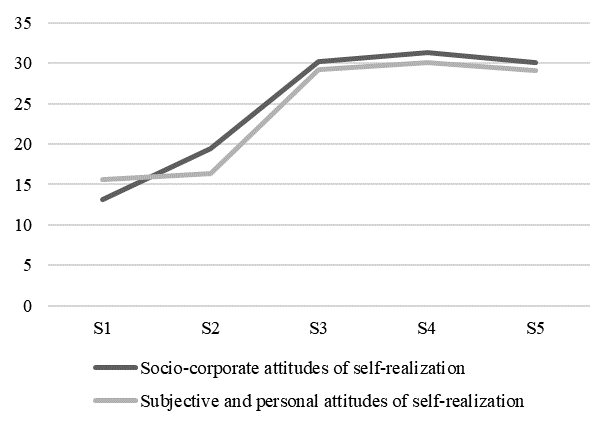
These scales for the subjects in the studied samples vary as self-control strengthens. The stronger self-control in the subjects, the more pronounced their social-corporate and subjective-personal attitudes of self-realization are.
The “Activity” scale reveals the strength or weakness of the properties of the nervous system (the properties of temperament) in the manifestations of self-realization. The “Inertia” scale indicates the predominance of stereotyping, passivity, low energy and purposefulness. In comparison, the average indicators (in%) for these scales are shown in Figure 2.
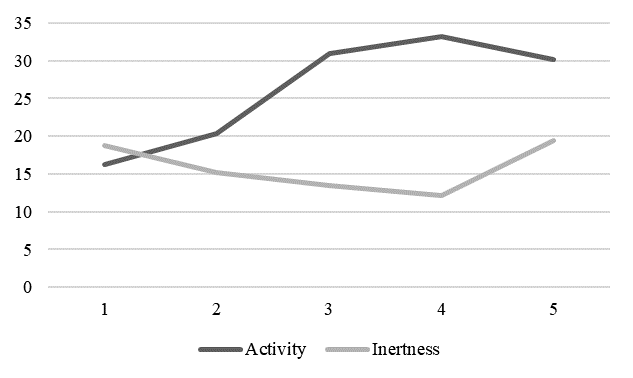
Indicators on the “Activity” scale are significantly higher in subjects with self-control above average (sample 4; 33.2%), and they also have the lowest values on the “Inertia” scale (12.2%). It is possible to make an assumption about the favorable influence of self-control on the activity of self-realization of the individual when it is above average.
The “Optimism” scale measures the characteristics of the psychoemotional mood and the dominance of positive emotions when a person starts a new project. The scale “Pessimism” characterizes negative psycho-emotional attitude of the subject of self-realization. In comparison, the average values (in%) for these scales are shown in Figure 3.
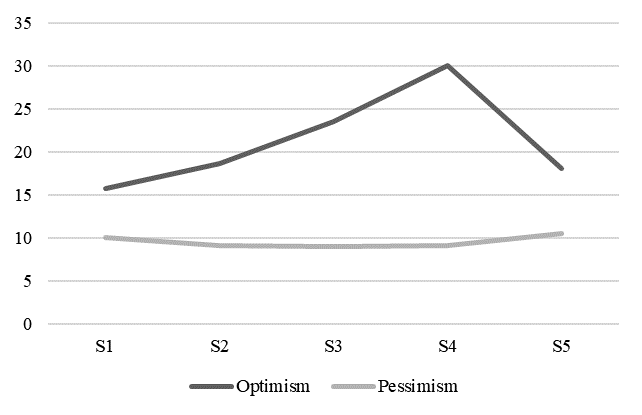
The highest indicators on the “Optimism” scale were found in the group of respondents with a higher-than-average level of self-control (sample 4; 30.1%). The lowest indicators were found in subjects with low and high levels of self-control (samples 1–15.8% and 5–18.1%). There were no significant differences between the indicators on the “Pessimism” scale in the study groups.
The “Internality” scale measures the level of self-control and self-organization of the individual. The ‘Externality” scale reveals the weakness of self-control of the subject of self-realization and the predisposition to shift responsibility to external circumstances. In comparison, the average values (in%) for these scales are shown in Figure 4.
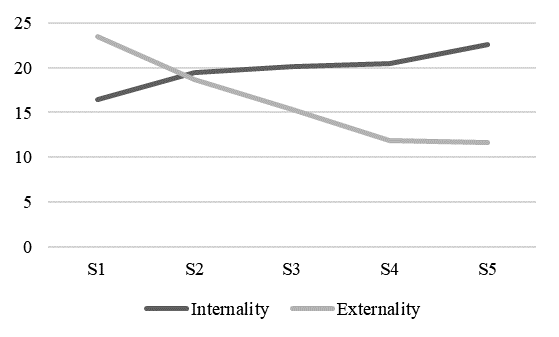
The highest indicators on the “Internality” scale were found in the group of subjects with a high level of self-control (sample 5; 22.6%), which indicates good self-control and self-organization in self-expression. In subjects with low self-control (sample 1; 16.4%), the indicator of internality is significantly lower than in the rest, while in this group of respondents the highest indicators on the “Externality” scale (23.5%) were revealed.
The scale “Sociocentric motivation” examines the dominance of socially approved motives of self-realization of the individual. The scale “Egocentric motivation of self-realization” reveals the dominance of narrowly personal motives of the subject of self-realization (the desire for financial independence, the motive of power). In comparison, the average indicators (in%) for these scales are shown in Figure 5.
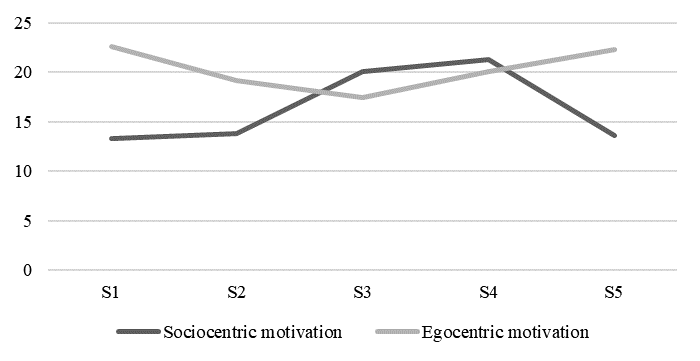
The highest indicators of sociocentric motivation for self-realization were found in groups of subjects with an average (20.1%) level of self-control and an above-average level (20.3%). Lower indicators on this scale were found in groups with low (13.3%) and high levels of self-control (13.6%). High indicators of egocentric motivation were found in the groups of respondents with low (22.6%) and high (22.3%) self-control.
The scale “Creativity” characterizes the manifestation of unconventional ways and techniques of self-expression of the individual. The scale of “Conservatism,” explores intellectual, communicative, and behavioral stereotyping. According to the statistical analysis (Student's-test), there were no significant differences between the indicators on these scales in the study groups.
The “Constructiveness” scale measures the effectiveness of self-realization, which is evaluated by the subject himself. The “Destructiveness” scale measures the degree of imperfection, unproductivity in assessing the results of self-realization of a person, and also indicates frustration in their abilities. In comparison, the average indicators (in%) for these scales are shown in Figure 6.
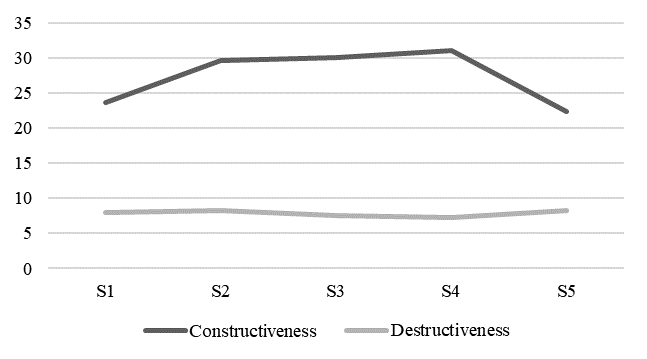
Indicators of constructive self-realization with the highest (31%) values were found in subjects with a level of self-control above the average (sample 4). The lowest indicators of constructive self-realization were found in respondents with a low (23.6%) and a high level of self-control (22.4%).
Indicators on the scale “Social barriers” characterize the difficulties in the manifestation of self-realization, due insufficiently developed methods and techniques of self-expression of the individual. The scale “Personal barriers” diagnoses personal characteristics that act as an obstacle to the full self-realization of the subject. In comparison, the average indicators (in%) for these scales are shown in Figure 7.
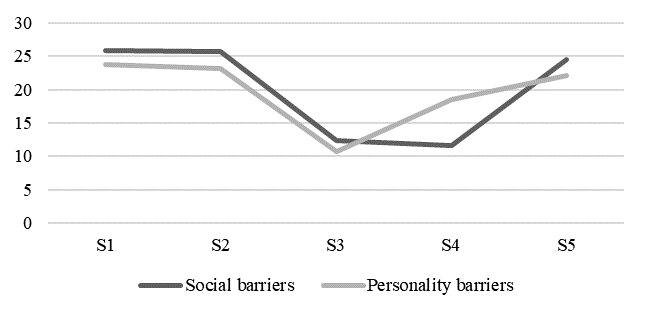
The most pronounced social and personal barriers were found in subjects with high (sample 5) and low (sample 1) and below average (sample 2) levels of self-management ability. The lowest indicators of self-realization barriers were found in groups 3 and 4 with average and above average levels of self-realization.
Based on the analysis of the obtained experimental data, we have identified the following specific features of self-realization in students with different levels of self-control:
- students with a low level of self-control are characterized by the manifestation of inertia, weak activity, destructiveness, the presence of barriers to self-realization, the priority of egocentric motivation for self-realization over sociocentric;
- for students with an average level of self-control in the process of self-realization, the manifestation of both sociocentric and egocentric motivation for self-realization is characteristic, rather high activity and weak inertia, the predominance of sociocentric motivation for self-realization over egocentric; in contrast to other groups of subjects, the lowest indicators of personal barriers to self-realization were revealed in this group;
- students with a high level of self-control are characterized by inertia, destructiveness, the presence of barriers to self-realization, the priority of egocentric motivation for self-realization over sociocentric.
Conclusion
Self-control, like the process of self-realization, is a creative one, and both of these phenomena involve new solutions, plans and strategies. With strong self-control, a person can make plans and decisions, but his or her self-realization will be hampered by the rigidity and lack of flexibility of these plans, resulting in inertia, destructiveness, barriers to self-realization, priority of egocentric motivation for self-realization over the sociocentric one. With a low level of self-management ability, the same difficulties arise, but the reason for this is the lack of a complete system of self-management, the predominance of emotional assessments over rational analysis of events. The most favorable, adaptive level for self-control is the level below the average: the subjects showed a high level of activity and optimism in the process of self-realization; they have the same high level of social-corporate and subjective-personal attitudes of self-realization, egocentric and sociocentric motives are equally present
References
Borzova, T. V., & Mosunova, L. A. (2020). The conditions for fostering meaningful understanding of information in learning. Science for Education Today, 10(1), 7-24. https://doi.org/DOI:
Bowlby, J. (2014). Emotional attachment to the mother (normal and pathological the third international congress on social sciences and humanities. In "East West" Association for Advanced Studies and Higher Education GmbH: The third international congress on social sciences and humanities, 167-174. Vienna.
Burdenyuk, G. M. (1992). Upravleniye samostoyatel'noy uchebnoy deyatel'nost'yu pri izuchenii inostrannykh yazykov vzroslykh. [Management of independent educational activities when studying foreign languages of adults]. Kishinev. [in Russ.].
Egorova, Y. N., Genvareva, Y. A., Zotova, T. A., & Nalichnikova, I. A. (2020). Professional self-realizationof a universitystudent: features, factors, conditions. CITISE, 2, 180-190.
Fomina, T. G., Burmistrova-Savenkova, A., & Morosanova, V. I. (2020). Self-regulation and psychological well-being in early adolescence: a two-wave longitudinal study. Behavioral Sciences, 10(3), 67-78.
Goukens, C., Dewitte, S., & Warlop, L. (2009). Me, Myself, and My Choices: The Influence of Private Self-Awareness on Choice. Journal of Marketing Research, 46, 682-692.
Halama, P. (2017). Self-Regulation Capacity and Decision Making of Slovak Managers in Routine Situations and in Situations with Possible Negative Outcomes. Studia Psychologica, 59(2), 156-168.
Kudinov, S. I., Kudinov, S. S., Kudinova, I. V., & Mikhailova, O. V. (2017). The role of persistence in students' self-realization. International Journal of Cognitive Research in Science, Engineering and Education, 5(2), 2017. 19-25.
Peysakhov, N. M. (1991). Dinamicheskiye pattern psikhicheskikh protsessov [Dynamic patternsof mental processes]. Kazan University publishing house. [in Russ.].
Pilotti, M. A. E., Alaouia, K. E., Mulhema, H., & Kuhayli, H. A. A. (2019). The Illusion of Knowing in College: A Field Study of Students with a Teacher-Centered Educational Past. Europe's Journal of Psychology, 15(4), 789–807.
Rusu, M. (2019). The Processof Self-Realization – From the Humanist Psychology. Perspective. Psychology, 10, 1095-1115.
Sava, S. L., Virga, D., & Palos, R. (2020). The Role of Teacher Support, Students' Need Satisfaction, and Their Psychological Capital in Enhancing Students' Self-Regulated Learning. Studia Psychologica, 62(1), 44-57.
Shevtsov, M. N. (2008). O vozmozhnosti ispol'zovaniya khronometricheskikh metodik dlya otsenki sposobnosti k samoupravleniyu [About the Possibility of Chronometrical Methods Usage for Evaluating the Ability to Self-Management]. Uchenyye zapiski Kazanskogo gosudarstvennogo universiteta, 150(3), 155-167. [in Russ.].
Weinstein, N., Deci, E. L., & Ryan, R. M. (2011). Motivational determinants of integrating positive and negative past identities. Journal of Personality and Social Psychology, 100(3), 527-544.
Copyright information

This work is licensed under a Creative Commons Attribution-NonCommercial-NoDerivatives 4.0 International License.
About this article
Publication Date
21 June 2021
Article Doi
eBook ISBN
978-1-80296-110-2
Publisher
European Publisher
Volume
111
Print ISBN (optional)
-
Edition Number
1st Edition
Pages
1-1168
Subjects
Social sciences, education and psychology, technology and education, economics and law, interdisciplinary sciences
Cite this article as:
Borzova, T. V., & Plotnikova, E. S. (2021). Specific Features Of Self-Realization In Students With Different Levels Of Self-Control. In N. G. Bogachenko (Ed.), Amurcon 2020: International Scientific Conference, vol 111. European Proceedings of Social and Behavioural Sciences (pp. 747-755). European Publisher. https://doi.org/10.15405/epsbs.2021.06.03.100

